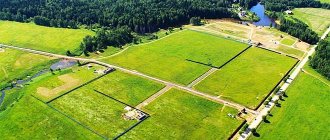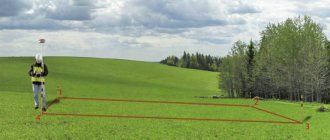Clarification of boundaries and other ways to resolve land disputes
Share on social networks:
In order to unquestioningly own a plot of land, it is necessary to know exactly where its boundaries lie. A plot of land may be registered and put on the cadastre, but Rosreestr may not have information about its exact boundaries. Today in Russia a huge number of areas do not have precisely established boundaries.
Or they are defined schematically, without determining the exact coordinates on the ground. All this invariably leads to problems. One of the most common problems is disputes and litigation with neighbors due to incorrectly established plot boundaries.
What is written in the law
For many years now, work has been underway in the Russian Federation, the purpose of which is to record land boundaries, as well as record the land itself.
To simplify such large-scale work, some amendments were made to legislative acts, namely:
- In the Land Code of the Russian Federation.
- In Federal Law No. 218, called “On State Registration of Real Estate”.
- In Federal Law No. 221 “On the State Real Estate Cadastre”.
Since in practice disputes regarding the boundaries of land plots have increasingly begun to arise, in addition to amendments to regulations, the law also stipulated that each land owner must prepare a boundary plan. Already in 2021 and 2022, without such a plan, it will be impossible to register your real estate and conduct transactions with previously registered real estate if the land surveying procedure has not taken place.
Water consumption standards
Water supply in a private house can be carried out autonomously or centrally. But the presence of water supply in the building itself is allowed only if there is a centralized sewerage system.
Certain standards exist not only for private households, but also for the entire village. They assume the presence of an accessible source of drinking water, around which an area is equipped.
Daily water consumption per person, according to the rules, is 50 liters if its source is a well for public use. If there is a centralized water supply and sewerage system, this norm can be increased to 160 liters.
What you need to know about land surveying
Demarcation of the territory is the first thing that needs to be done in order to avoid future disputes about the boundaries of the land. It is the land surveying procedure that allows the owner of each plot to legally determine their boundaries, and moreover, to secure them.
It is necessary to determine the boundaries if in the future it is planned to do the following with the site:
- divide into several separate ones;
- privatize;
- clarify its boundaries;
- obtain the necessary documents that will allow construction work to be carried out;
- obtain a cadastral passport or other documents for the plot;
- allocate land if it is in common ownership.
Before ordering a survey, you need to make sure that you have the following package of documents on hand:
- Identity card (passport).
- Cadastral document for the plot.
- Documents indicating the existence of land ownership.
- Extract from the Unified State Register of Real Estate.
It is worth knowing that only the owner of the site has the right to order a land surveying procedure. The person who leased the land does not have such a right.
Minimum fire clearances
According to existing standards, houses should not be located close to each other. The distance between them is determined by the material of the walls and ceilings:
- If both buildings are built of stone, brick or concrete, then an interval of at least 6 m should be maintained;
- If the ceiling of one of the houses is made of flammable materials, then this distance increases to 8 m;
- In the case when flammable materials are used as floors of both buildings, the distance is 10 m, and if the external walls are made of timber - 15 m.
These fire safety standards apply only to the minimum distances between residential buildings that are located on different sites.
Land disputes
Very often, conflicts arise between neighbors of two plots of land due to the fact that they cannot accurately determine the boundaries of their lands. If the dispute cannot be resolved peacefully, then it is best for both owners of adjacent plots to go to court. This is the only way to save your personal money and time.
ATTENTION !!! As statistics show, land disputes are considered one of the most complex on the territory of the Russian Federation. This is explained by the fact that at the legislative level this area does not yet function entirely correctly. And that is why disputes over the boundaries of the land can last for more than a year.
Every owner of a plot of land should know that he can protect himself from possible conflicts with neighbors, but only if he follows these recommendations:
- carefully review the documents provided by the engineer after carrying out cadastral work. It is at this stage that problems very often arise, and they can be resolved in time;
- in the event that the boundaries of the land plot were determined a long time ago, then it is best to make a new request to remove the boundaries in order to personally determine for yourself whether the current boundaries correspond to the previously defined ones.
First of all, if a conflict arises with neighbors, you should make sure that you are right, and only then contact a judicial authority.
Neighbor put up a fence on public land
Grabbing public lands is a popular issue. Installing a fence on it is a violation of the law. Moreover, it doesn’t matter whether it bothers the neighbors or not. In this case, the offense is formed by the very fact of seizure.
In order for a fence facing the red line to be installed in accordance with the law, the following nuances must be taken into account:
- When installing a fence, you need to retreat half a meter deep into the site. It is necessary that the gate swings open on the property of the owner;
- if the fence is on the border, then the gate should open inside the site.
Regional regulations may provide for additional restrictions.
Note! Placing a front garden on the area in front of the house is not always a violation of the law. In a number of regions, the land under the front garden is classified as public land. But laws set a limit on the size of the front garden. If it complies with the established standards, then the construction of a fence does not constitute a violation or land grab.
For example, in Abakan, front gardens are classified as common lands, but in the Altai Territory they are not.
How to file a claim for flooding of an apartment by neighbors?
How to draw up a report on flooding of an apartment by neighbors above? Sample
The most common causes of disputes
Against the backdrop of constant conflicts between the owners of adjacent plots, standard prerequisites were established by which it can be determined that the dispute will go into court proceedings.
As a rule, this happens if:
- Errors were found in the real estate documents, which were also entered into the Unified State Register of Real Estate. This may mean that the boundaries of the plots were superimposed on each other.
- The cadastral engineer made incorrect calculations when taking measurements. It is worth noting that you can prove the engineer’s mistake only if you order another survey procedure.
- Independent seizure of someone else's territory. In case of squatting, neighbors, as a rule, without any legal grounds, move the fence to someone else's land. This leads to a decrease in the territory of the other owner, and moreover, this happens illegally. In such a situation, it is important to try to talk to your neighbors. But if they do not agree to a peaceful solution to the problem, then it is worth bringing the court to trial. If the judicial authority rules in favor of the plaintiff, the borders will be restored.
With the onset of 2021, and in 2022 as well, the land surveying procedure must necessarily be agreed upon with the owners of adjacent plots. If the rights of neighbors were not taken into account during the land surveying process, then the result of the procedure may be considered invalid, even if they are already included in the Unified State Register of Real Estate.
Lawyer's answers to private questions
Neighbors built a store on public land near the house. Cars drive up to the store and block the passage to my house. Where to complain?
In this situation, you need to file a complaint with Rosreestr, the district administration and the prosecutor's office.
We live in the private sector. The neighbor pulled the fence up to the road. It is almost impossible to get to the house. What to do?
File a complaint with Rosreestr. The neighbor will be held accountable and forced to return the fence to its place.
There was a passage between the sites. The neighbors moved the fence and closed it. I started driving to the house through the territory of the enterprise, which is located on the other side of the site. But now they want to ban travel through the territory of the enterprise. This means I won't be able to drive home. What to do?
According to the layout, it cannot be that there is no access to the site. Contact the district administration and look at the urban planning plan. In it you will find legal access to the house. After which you need to file a claim against the person who blocked this passage.
How to start resolving disputes
As already mentioned, when conflicts arise with neighbors, first of all it is worth trying to solve the problem peacefully.
And only if this fails, then you should proceed to the following steps:
- If an error is identified in the Unified State Register, you must send an application to Rosreestr and ask for it to be corrected. In addition to the application, you must attach documents to it that can confirm the presence of an error. As a rule, after three days, Rosreestr employees will make a decision: they will correct the error or refuse it, since all the information specified in the Unified State Register will be reliable.
- Clarify your boundaries in relation to adjacent areas. This is the only way to prove your rights in court. Also, the presence of accurate data on the boundaries of plots can, in some situations, convince other neighbors of the reliability of the data, and then there will be no need to go to court at all. To determine the exact boundaries of the territory, it is necessary to invite a cadastral engineer. After cadastral work is carried out, an approval act is drawn up, which must be signed by the owners of adjacent plots. It is worth noting that before carrying out the land surveying procedure, it is necessary to tell those interested in resolving the dispute about this at least 7 days before the procedure itself.
IMPORTANT !!! In the event that one of the neighbors cannot be present during the cadastral work, then the engineer himself is allowed to sign the agreement. If, however, the neighbors did not show up for the land survey after the notification, then, as prescribed by law, the act of approval can be approved without their signature. As Federal Law No. 218 states, namely its 43rd article, if one of the owners of adjacent plots does not agree to agree on the boundaries of the plot, the resolution of the issue is referred to the court. After one of the neighbors refuses to clarify the boundaries, a statement of claim is attached to the agreement.
Requirements for the location of fences and barriers
Construction regulations that relate to the construction of fences are most often only advisory in nature.
The fence between neighboring areas should not be continuous, and its height cannot be higher than 1.5 m.
If the external fencing is planned to be more than 2 m high, then this issue will need to be agreed upon with the architecture department; its material is not regulated.
When the border of the site runs along the highway, any fence whose level exceeds 1 m requires approval.
Distance between pillars
When installing fences, this parameter is regulated only by technical conditions, most often depending on the material from which they are made.
Solid fences are built from slate, traditional brick, concrete, wooden boards, and for transparent fences they use chain-link mesh, wood picket fences, and polycarbonate panels.
Typically, the distance between adjacent pillars is 2-3 m. The supports are immersed in the load-bearing soil to a depth of 80-90 cm; it is advisable to concrete the base.
When calculating the distance between pillars, you must consider:
- what material is used as a support;
- the presence of a foundation and its type;
- wind and snow loads of the area;
- location of the site.
You can clarify the standards in force in a given locality in the architectural department of the local administration.
How will a neighbor who squatted be punished?
If the owner of a land plot has identified the fact of illegal seizure of land, he has the right to contact a land inspector, who, after the appeal, arrives at the site where a violation of the owner’s rights was discovered. Upon arrival, the inspector carries out an inspection and draws up a corresponding protocol. If a violation has indeed been identified, then the occupier of the territory is issued an order, which states that within a certain period of time he must remove his illegal buildings on someone else’s land, and also pay a fine of 1,000 rubles.
We do not violate the rights of neighbors or about planning rules in numbers
Let us remind you about the distances, the minimum values of which to the neighboring plot must be observed when planning summer cottages in accordance with SP 53.13330.2011:
- at least 3 meters from the house and at least 6 meters from the windows of the living rooms of your house to the buildings on the neighboring site;
- at least 1 meter to the bathhouse, garage, barn and other buildings;
- at least 4 meters to structures where livestock or birds are kept;
- at least 1 meter for bushes, 2 meters for medium-sized trees and 4 meters for tall trees.
Distances to the boundaries of the neighboring plot are measured from the base or from the wall of the building, if the elements of the structure (porch, roof overhang, etc.) protrude no more than 50 cm from the plane of the wall. If more than 50 cm, then the distances are calculated from the protruding parts or their projection onto the ground.
NB ! The norms of the mentioned SP 53.13330.2011 do not apply in cases of individual housing construction. They need to be clarified at the level of local authorities.
Important points are also fire breaks, that is, a distance of at least 3 meters from the neighboring fence and at least 5 meters from the red lines (areas where power lines, roads, communication networks, etc. are located).
The norms of insolation or shading are 3 continuous hours during the spring-summer period or 3.5 hours of total duration.
What documents need to be prepared to resolve a dispute in court?
As the Code of Civil Procedure of the Russian Federation states, namely its Article 132, a claim filed in court must be supported by relevant documents.
As a rule, the annexes to the statement of claim are:
- papers indicating the right to own the site;
- boundary plan;
- an extract from the register about a neighboring plot with the owner of which a dispute has arisen;
- receipt for payment of state duty;
- other papers that may influence the court's decision in favor of the applicant.
If the plaintiff, when going to court, does not have a boundary plan in hand, then it is allowed to present a more detailed extract from the register instead. But if the court considers the absence of a land survey plan to be unacceptable for resolving the issue, then the hearing is postponed until a land survey plan is provided.
Demolish the bathhouse: the court ordered the dismantling of the unauthorized structure
A similar situation happened in the Tukaevsky District Court of the Republic of Tatarstan in 2021.
The plaintiff asked the court to demolish the unauthorized building (bathhouse) of his neighbor, which was built in violation of the permissible distances.
From the case materials it follows that there were violations of SP 53.13330.2011 during the construction of a garden house and bathhouse on the site. Facilities for collecting bathhouse wastewater are located less than a meter from the border of the neighboring property. There are also violations of SP 4.13130.2013 regarding fire breaks. Thus, these violations can lead to a threat to life and health in the event of a fire, as well as to negative impacts on the soil in both areas. It is also confirmed that the bathhouse is an unauthorized construction.
The court considered the plaintiff's demands justified and ordered the defendant to demolish the bathhouse.
How does the trial take place?
Both the plaintiff himself and his lawyer can be present at the court hearing, with whom he must first enter into an appropriate agreement. As the Code of Civil Procedure of the Russian Federation states, namely its Article 30, to resolve land disputes it is necessary to contact the territorial judicial body. That is, you need to send the claim to the court, which is located at the location of the land plot.
ATTENTION !!! After consideration of the issue by the judicial authority, if the plaintiff’s requests are satisfied, that is, a positive decision is made in his favor, then it comes into effect within one month. During these 30 days, the defendant has the right to appeal to a higher authority and even to the Supreme Court of the Russian Federation.
As Federal Law No. 218 states, namely Articles 14 and 61, the court decision is transferred to Rosreestr. As a rule, the court demands Rosreestr to either correct existing errors or register the property. In order not to wait until the court sends the relevant document to Rosreestr, you can take a copy of the document certified by the court and hand it over to the Rosreestr department in person.
Sanctions for violation of norms
Planning a site allocated for the construction of a private house is a creative and multifaceted process, but at the same time one should not forget about the requirements that must be met. An unscrupulous developer may be called to account by the government agency exercising supervision or by the person whose rights were violated.
In this case, penalties provided for by the Code of Administrative Offenses are imposed. Their size can be precisely determined by the severity of the offense or limited to a previously known limit.
In addition, the structure may be recognized as an unauthorized construction, as a result of which a decision may be made to demolish it. For dismantling, third-party specialists may be involved, or it may be carried out by the violator himself.
Did you find this article helpful? Please share it on social networks: Don't forget to bookmark the Nedvio website. We talk about construction, renovation, and country real estate in an interesting, useful and understandable way.










